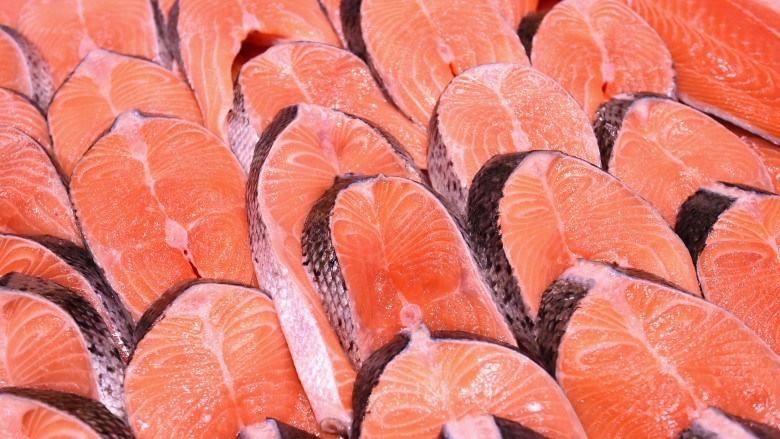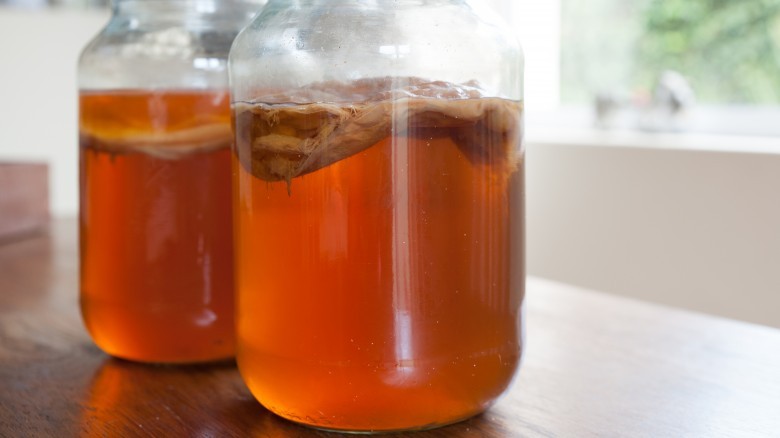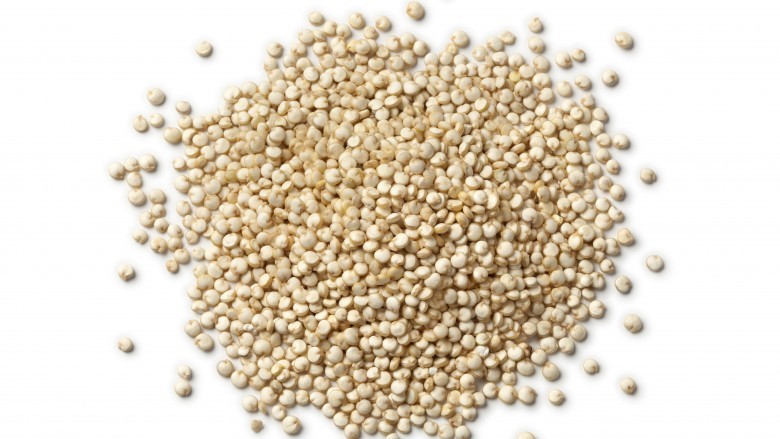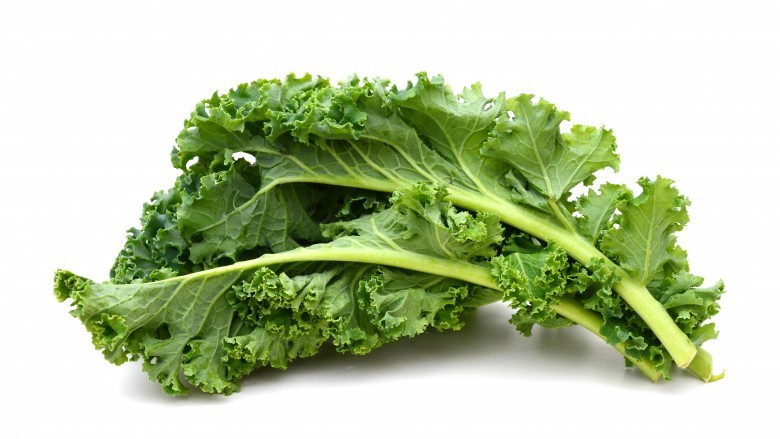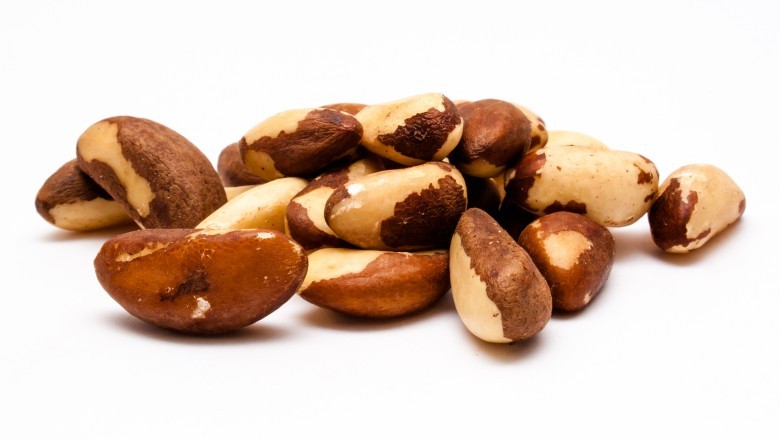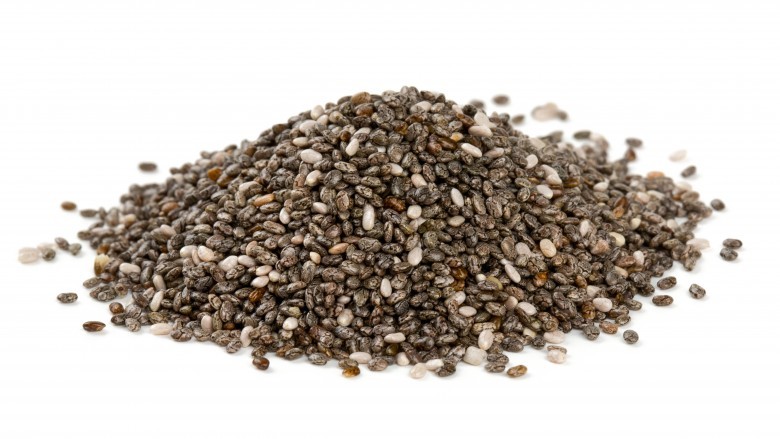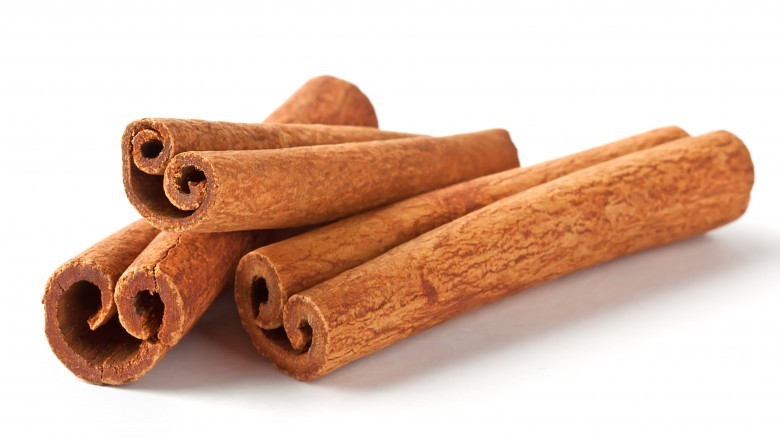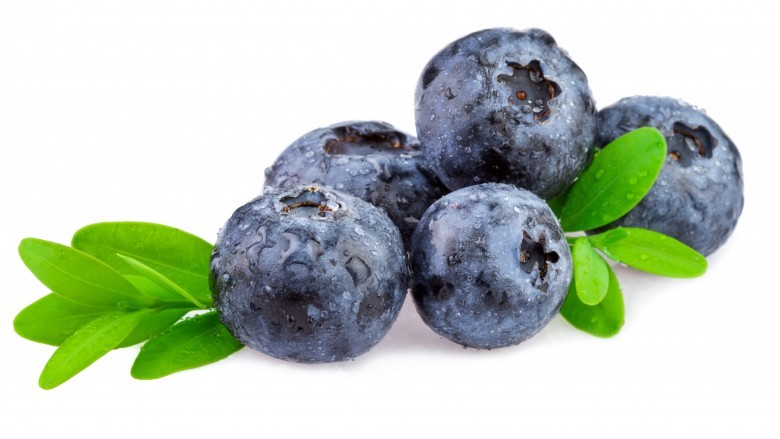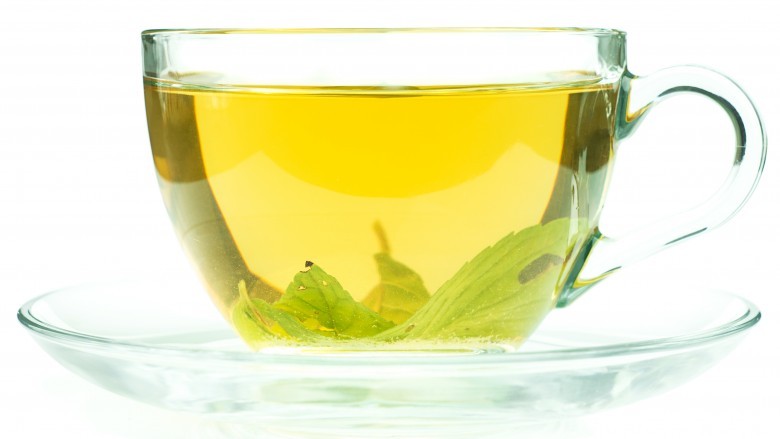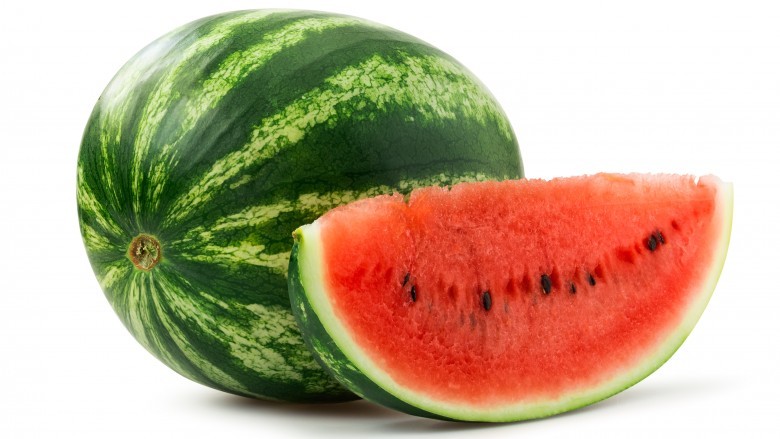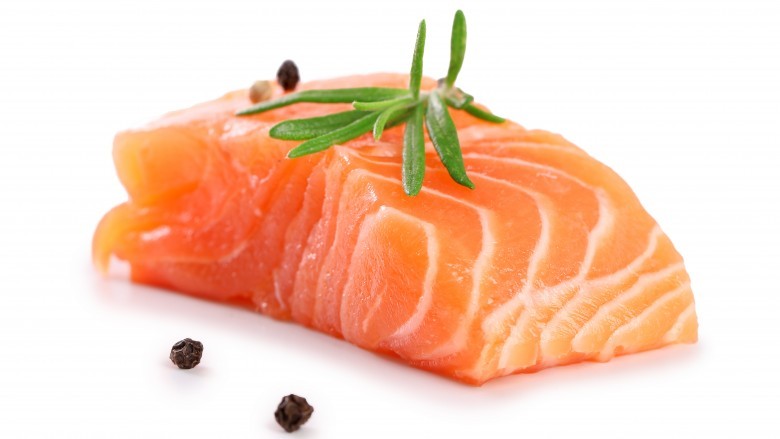Superfoods That Could Be Terrible For You
It's not really very clear how a food gets labeled as a "superfood" because it's not like it's the FDA making that decision. And whether the food in question actually has special qualities or is merely a profitable candidate for marketing, the least you can hope for is that eating them probably won't do you any harm. Unfortunately, even if a food does deserve that most impressive title, it could still be terrible for you.
Kombucha
Kombucha is a fermented black tea that is claimed to offer numerous remarkable health benefits to anyone who drinks it. Some of those claims are backed up by science and some are still waiting for more studies to be done. So if you can get past the giant slimy scoby (a lump of bacteria and yeast) floating in the jar as you pour off your daily sample), perhaps it will do wonderful things for you.
Unfortunately, what it might also do is no good at all. Kombucha is fairly acidic, and it's packed with lactic acid. According to the CDC, there were two cases of unexplained severe illness associated with the consumption of kombucha in Iowa in 1995. Two women were hospitalized, one after being found unconscious by a neighbor, and the other less than two weeks later after suffering from shortness of breath. Both had high levels of lactic acid in their blood and had been drinking kombucha for several months made using the same fungal culture. The first woman had several preexisting conditions and died a couple of days after suffering a cardiac arrest. The second woman also suffered a cardiac arrest but recovered and was discharged. A case reported in 2009 involved an HIV-positive man who was hospitalized with a fever and shortness of breath 15 hours after consuming kombucha. He was suffering from lactic acidosis and required sedation and intubation before he recovered.
Since kombucha is often made at home and many people don't actually know what they're doing, the conditions of production can have a significant effect on the quality of the final product. As a result there have been several cases of lead poisoning caused by the acids in kombucha leaching lead out of the glaze on ceramic fermenting jars. One batch of kombucha was even found to contain anthrax due to the unsanitary conditions it was made in. Due to the potential dangers connected with consuming kombucha, it is not recommended for pregnant women, or people with preexisting conditions ... or (if you ask me) anyone else, really.
Quinoa
Since it's called a superfood, you already know quinoa will probably heal the sick and raise the dead, right? Maybe not. While it does appear to contain many valuable nutrients, it isn't a completely innocent grain. One of the nutrients it is particularly good for is dietary fiber, but if you aren't used to consuming high doses of fiber, you could find yourself getting very gassy or even ... runny. Quinoa is also high in oxalic acid, which mostly passes out of your body when you pee but which has the potential to combine with calcium and form kidney stones, especially if you're already susceptible. The biggest danger with quinoa, however, involves one of its natural defense mechanisms. As a defense against insects, quinoa is naturally coated in saponins. This makes them less dependent on insecticides than other crops, but the saponins can impart a bitter taste to the finished food. If the saponins aren't thoroughly removed, they can even occasionally cause stomachaches, diarrhea, and small intestine damage. There's nothing super about that.
Cruciferous vegetables
In an amazing turnabout, formerly unfashionable dietary greenery like Brussels sprouts, broccoli, kale, and other cruciferous vegetables have been reborn and rebranded as superfoods. And so long as they're prepared in a halfway interesting way, that really is nothing but good for the people who eat them. Unfortunately, if you suffer from an iodine deficiency, you might want to reconsider that kale smoothie in the morning.
Your thyroid uses the iodine in your diet to produce hormones essential to your health, but cruciferous vegetables are loaded with goitrogens that act in several ways to interfere with this process, potentially risking hypothyroidism or even a goiter. In an extreme example involving people suffering from iodine deficiencies in New Caledonia, the goitrogens in cruciferous vegetables have been associated with increased rates of thyroid cancer. You get the most goitrogens when you consume uncooked vegetables, and since it takes a lot of kale to fill a glass, a kale smoothie offers a particularly high dose of the "anti-thyroid" compound. Of course, begrudging cruciferous consumers probably don't have anything to worry about, but superfood and kale fanatics might be wise to remember that if a little is good, an overdose isn't always better.
Brazil nuts
Once in a while a food item turns up that actually deserves to be called a superfood. And although Brazil nuts are certainly powerful, it's not a controlled-and-responsible-Superman kind of power so much as it is a be-careful-where-you-point-that-Hulk-then-stand-back kind of power. That's because along with many other very valuable nutrients, Brazil nuts contain a significant quantity of selenium. Selenium is an important nutrient that your body needs, and it naturally occurs in many foods. According to superfood advocates, Brazil nuts even have anti-cancer potential, and while that makes for good marketing, it might also make for overdose by enthusiasm.
According to the National Institutes of Health, the recommended dietary allowance for adults is 55 micrograms a day, and the maximum recommended amount is 400 micrograms a day. One ounce of Brazil nuts (usually about eight nuts) contains 544 micrograms of selenium, well over the recommended maximum. In fact, just a single Brazil nut can provide enough selenium to check the box on that nutrient each day, and that's assuming you're not getting any selenium elsewhere, which you probably are. Make it a habit to absentmindedly shove handfuls of Brazil nuts in your mouth, and you're easily putting yourself at risk of selenium toxicity, the symptoms of which range from hair loss to kidney failure and all the way to death.
Chia seeds
Chia seeds are another nutritious grain that's been burdened with excess hype. One of the biggest claims surrounding chia seeds is based on the amount of omega-3 fatty acids they supposedly hold, namely that they contain more than salmon. But while that is technically true, there's more to the story. Omega-3 acids come in three varieties: DHA, EPA, and ALA. The first two naturally occur in fish oil and are essential for our health. ALA, however, is the kind that occurs naturally in chia seeds. We don't really need it. Our bodies can convert ALA to DHA and EPA, but they do this so badly that the amount of usable omega-3 you get is actually way less than naturally occurs in the pink fish. However, as much as that misinformation is annoying, it's not fatal. What could be fatal is the ability of chia to absorb water and expand in the process. Chia seeds can absorb 27 times their weight in water, so if you have swallowing problems and you eat chia seeds dry and they expand in your throat, you could have a bigger problem than an omega-3 deficiency. Yes, this is relatively unlikely. But yes, it really sent a man to the emergency room.
Cinnamon
In the cold winter months (and also the rest of the year), adding a bit of cinnamon to your food is comforting and delicious. If you're a superfoodie, however, you might skip the food and comfort and just take it in pill form instead. That's because cinnamon is credited, largely without scientific confirmation via studies in humans, to help treat diabetes, act as an anti-inflammatory, protect the heart, lower cancer risk ... the list is long. However, it is important to understand that cinnamon contains coumarin, which can be toxic and cause liver damage if taken in too high a dose.
There are two types of cinnamon: Ceylon (which is more expensive and contains very little coumarin) and cassia (which is much cheaper, more common, and can contain more coumarin). If you're just eating the occasional cinnamon bun or even baking with it regularly, you shouldn't have anything to fear. But if you're adding it to everything you cook or taking a large daily cinnamon supplement, you might be putting your liver in some cinnamon-spiced danger.
Blueberries
There's no denying that blueberries are delicious and nutritious, and people would probably keep eating them even if they weren't that good for you. Blueberries were given their colorful superhero cape on the strength of the antioxidants they contain. They also bring along quite a lot of fiber at 4 grams per cup, which is great if you have trouble with digestion. However, if you're already getting plenty of fiber in your diet, the sudden and regular addition of a couple cups of blueberries to that equation could leave you suffering from cramps with a side order of bloating and odorous emissions.
However, the real danger of eating blueberries affects people who have salicylate sensitivity. Blueberries contain large amounts of salicylates, which are also the major ingredient in aspirin. For people who are sensitive, consuming blueberries can cause any number of unpleasant side effects, including rashes, swelling, and even anaphylaxis, which can be life-threatening. For some people, even just a small amount of salicylates can cause symptoms, and so those people definitely shouldn't try and consume any form of blueberry juice, since that contains even more of the stuff—adding some serious drawbacks to any "pleasure" they might have found in that glass.
Green tea
Green tea, despite its healthy alternative-medicine reputation, actually contains almost as much caffeine as coffee. And when combined with a few other characteristics, makes this herbal infusion a riskier prospect than most people realize. The caffeine alone can cause sleeplessness, tremors, irregular heartbeat, high blood pressure, migraines ... the list is long, and it doesn't take many green tea cups' worth of caffeine to start checking things off for some people. At the risk of corrupting a popular idiom: with medicine like this, who needs poison?
Watermelon
Watermelon is one of the great pleasures of summer dining, combining sweetness, refreshment, and nutrition in one juicy mouthful. But as you won't be at all surprised to discover, there's a catch. Lycopene is the chemical responsible for the red color in tomatoes as well as our favorite summer snack, and watermelons contains 18 to 26 milligrams per slice. If you subscribe to the theory that lycopene is a powerful antioxidant, that's a good thing. Unfortunately, if you're not accustomed to consuming large quantities of lycopene and you chow down on a healthy pile of watermelon, you could experience some gastrointestinal disturbances.
Watermelon is also a good place to find potassium, around 560 milligrams per slice, but for anyone diagnosed with hyperkalemia or kidney problems, that could be enough to cause all sorts of serious heart problems up to and including cardiac arrest. However, if you're a man with healthy kidneys and no history of hyperkalemia, but you suffer from a lack of enthusiasm in the pants department, then you might want to ignore this warning and chow down. Because, according to researchers at Texas A&M, consuming large quantities of watermelon can put extra nitric oxide in your blood, which relaxes blood vessels and might help things perk up. Just hope you aren't stuck in the bathroom experiencing gastrointestinal disturbances.
Salmon
Salmon are pretty special. They're full of useful omega-3 acids, protein, bright colors, and lots of tasties. And unlike many other "super" items, all the bad things that salmon can do to you aren't inherent to the little pink beasties but instead have been thrust upon them without permission. Mercury is found in most aquatic organisms and can be found in greater quantities as you move up the food chain. Levels also vary depending on geographic location and whether the fish is wild or farm-raised. According to the U.S. Food and Drug Administration, the levels of mercury in salmon are low, and so long as you aren't eating it with every meal you should be fine.
However, the same cannot be said for pregnant women or small children because young children are particularly vulnerable to the negative neurological effects. In a slightly grosser twist, according to the Washington Post, a parasite formerly thought to live only in the waters around Japan has been found living in wild Alaskan salmon. The parasite in this case is the Japanese broad tapeworm, and if you're lucky enough to eat an infected piece of fish, it will take up residence in your intestine and act like the best friend you didn't know you had: sharing your meals, sleeping in the same bed, and awkwardly appearing in the bathroom while you're on the toilet. Truth be told, you aren't actually in much danger of picking up this most unwanted BFF, but if you want to reduce the chances to zero you just need to cook the salmon before you eat it. Unfortunately, while baking salmon cuts the pathway to parasite paradise, it does nothing at all for the mercury. At least you can't blame that on the fish.
